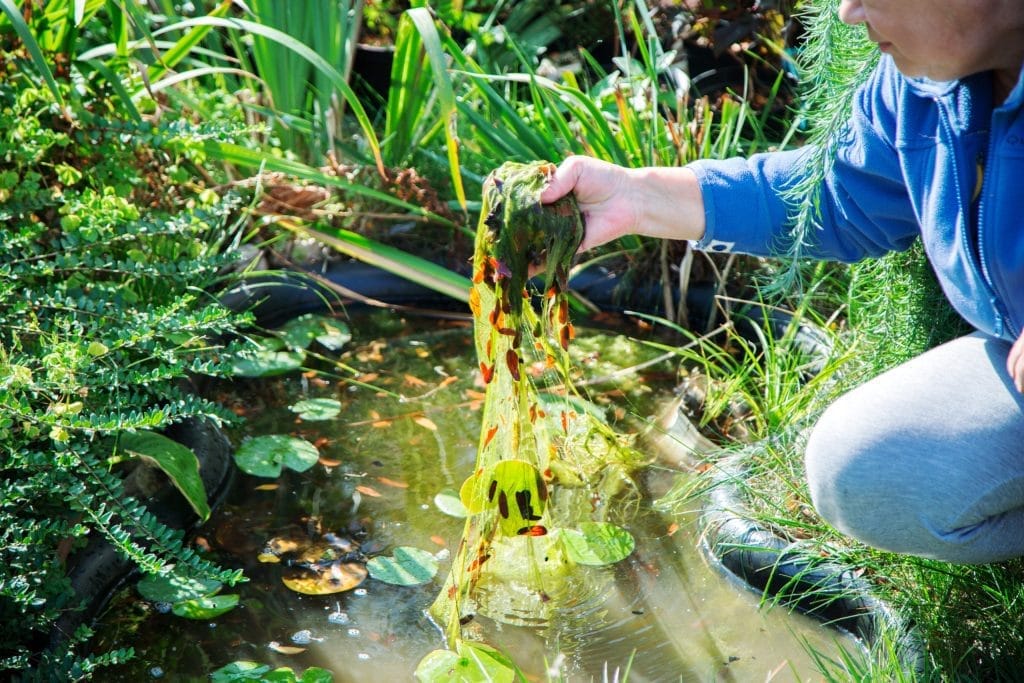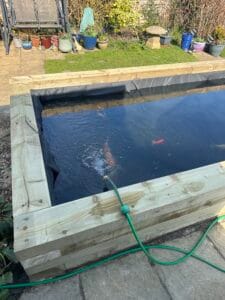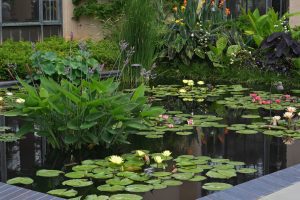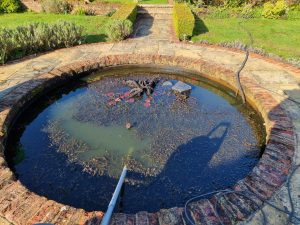
How Can I Get Rid of the Blanket Weed in My Pond? Effective Strategies and Solutions
Blanket weed can be a frustrating problem for anyone with a garden pond.
Regularly removing it by hand is often the most effective way to keep it under control.
This unsightly algae not only diminishes the beauty of the pond but can also harm fish and plants if left unchecked.

There are several methods available to manage blanket weed effectively.
Pond owners can choose from manual removal, biological treatments, and even chemical options, depending on their preferences and pond conditions.
Understanding the various approaches helps in finding the right balance to maintain a healthy pond environment.
Maintaining proper pond conditions and being proactive can prevent blanket weed from becoming a major issue.
With a little effort and the right techniques, anyone can enjoy a clear, vibrant garden pond free from the hassle of algae.
Key Takeaways
- Regular manual removal of blanket weed is highly effective.
- Biological and chemical treatments can help manage algae growth.
- Proper pond maintenance and preventive strategies are key to a healthy environment.
Understanding Blanket Weed
Blanket weed is often a concern for pond owners.
Knowing its causes, how nutrient levels affect its growth, and the types of algae can help manage this issue effectively.
Causes of Blanket Weed Growth
Blanket weed, or filamentous algae, thrives in ponds due to a combination of factors.
Key causes include excess nutrients, particularly phosphates and nitrates, which often come from fish waste, decaying plants, and leftover food.
When these nutrients build up, they promote rapid algae growth.
Sunlight also plays a significant role.
When ponds receive too much sunlight, it can spur the growth of blanket weed. Adequate shade from overhanging plants may help reduce its spread.
Regular maintenance, such as removing organic waste, can manage these nutrients and help maintain a healthier ecosystem.
The Role of Nutrient Levels
Nutrient levels in pond water significantly impact the balance of aquatic life.
Phosphates and nitrates are essential for plant growth but can lead to algae blooms when present in excess.
Fish waste contributes to these nutrient levels, as it breaks down into compounds that algae feed on.
Controlling nutrient levels involves monitoring the input from fish and other organic materials.
Regular water changes and using plants to absorb excess nutrients can help keep levels in check.
This balance is crucial for the overall health of the pond and its inhabitants.
Identifying Different Types of Algae
Understanding the various types of algae in a pond is essential for effective management.
String algae and blue-green algae are common alongside blanket weed.
While string algae appear as green strands, blue-green algae can form thick mats, which may indicate nutrient imbalance.
Identifying these algae types allows for targeted treatment.
For instance, while some algae can help improve water quality through photosynthesis, excessive growth can lead to low oxygen levels.
Knowing these differences helps pond owners choose the right management strategies to enhance pond health.
Manual Removal Techniques

To effectively manage blanket weed in a pond, manual removal techniques are essential. These methods help keep the pond clean and free from debris and organic waste, reducing the growth of blanket weed.
Tools and Methods for Removing Blanket Weed
When tackling blanket weed, it is vital to use the right tools.
A pond net or rake can be very effective for physically pulling the weed out of the water. These tools allow for easy collection, preventing pieces from settling back into the pond.
Another method is to use a garden fork or similar implement to loosen the blanket weed at the roots. This makes removal easier.
It is important to dispose of the removed weed properly to stop it from regrowing.
Regular checks for debris and organic waste in the pond can also aid in prevention.
When cleaning, ensure the pond’s environment is balanced to minimise the chance of reoccurrence.
Biological Treatments

Biological treatments focus on using natural methods to manage blanket weed in ponds. They emphasise the balance of the aquatic ecosystem and leverage living organisms to maintain a healthy pond environment.
The Role of Pond Plants
Pond plants play a crucial role in controlling blanket weed.
Aquatic plants such as water lilies and marginal plants can shade the water surface, reducing sunlight penetration. This decrease in sunlight slows the growth of blanket weed.
Oxygenating plants improve oxygen levels in the water, benefiting all pond wildlife.
As these plants absorb nutrients, they compete with algae, effectively starving blanket weed.
Incorporating a mix of aquatic plants ensures a balanced ecosystem and helps maintain clear water.
Adding a variety of species, including both submerged and floating plants, creates a diverse habitat that supports beneficial interactions among pond life.
Utilising Beneficial Bacteria
Beneficial bacteria are vital in managing blanket weed.
They break down organic matter and excess nutrients in the water, which are often the root causes of algae growth.
By introducing specific bacterial treatments, pond owners can create an environment less conducive to blanket weed.
These bacteria thrive in healthy, balanced ecosystems.
They enhance water quality by consuming phosphates and nitrates.
Implementing these treatments alongside aquatic plants leads to better oxygen levels, which further supports fish and wildlife.
Regularly monitoring the pond’s health and adjusting the balance of bacteria and plants can keep blanket weed at bay effectively.
Chemical Control Methods

Chemical treatments can be a quick way to tackle blanket weed. It is essential to choose effective options while considering the health of the pond ecosystem. Understanding the right chemicals can help ensure the desired outcome without harming fish and plants.
Selecting Effective Chemical Treatments
When choosing chemical treatments for blanket weed, look for products specifically designed for algae control.
Many of these contain active ingredients that target filamentous algae while being safe for aquatic life.
Common chemical options include:
Algaecides: These are effective against various types of algae, including blanket weed. It is crucial to follow the manufacturer’s guidelines for dosage.
Phosphate Removers: High phosphate levels can encourage the growth of blanket weed. Using a phosphate remover can help maintain a balanced environment.
Water Treatments: Some products combine algaecides with water conditioners to enhance pond health while controlling weed growth.
Always read labels carefully to avoid harming beneficial organisms in the pond.
Barley Straw Application

Barley straw is a natural method for controlling blanket weed and reducing algae growth in ponds. It works by releasing compounds that inhibit the growth of unwanted aquatic plants. Proper application is crucial to achieve the best results.
How Barley Straw Works
Barley straw becomes effective as it decomposes in water.
During this breakdown process, it releases substances that create hydrogen peroxide and other compounds. These compounds help to prevent the growth of algae, including blanket weed.
To use barley straw effectively, the right amount should be applied based on the pond’s size.
A general guideline is to use about 50 grams per square metre of water surface.
It typically takes about six weeks for the straw to start showing results.
Regular application can help maintain lower levels of blanket weed throughout the growing season.
Applying Barley Straw Extract
Barley straw extract is a more concentrated form and can be easier to apply.
This product skips the decomposition phase, allowing for quicker action against blanket weed.
When using barley straw extract, make sure to follow the manufacturer’s instructions for dosage. This usually involves measuring the extract based on the pond size.
In contrast to traditional straw, the extract is less messy and can be used year-round.
This can help keep algae growth at bay more effectively, especially in larger ponds where traditional methods may be harder to manage.
Pond Filtration Systems
Pond filtration systems play a key role in managing water quality in garden ponds. They help to reduce nutrient levels and maintain clear water, which is essential for the health of aquatic life. Understanding how to choose and maintain a pond filter is crucial for effective control of algae like blanket weed.
Choosing the Right Pond Filter
Selecting the right pond filter depends on various factors, including the size of the pond and the types of fish and plants present.
There are three main types of pond filters: mechanical, biological, and UV filters.
- Mechanical filters remove debris and particles from the water.
- Biological filters support beneficial bacteria that break down harmful substances.
- UV filters use ultraviolet light to kill algae and some pathogens.
When choosing a filter, consider the pond’s volume in litres.
A good rule of thumb is to select a filter that can handle twice the pond’s volume per hour. This helps ensure that water remains clean and clear, reducing the impacts of high nutrient levels that contribute to blanket weed growth.
Maintaining Your Filter for Optimal Performance
Regular maintenance of the pond filter is vital for its efficiency. This involves cleaning filter media every few weeks, checking for clogs, and ensuring no build-up of organic waste occurs.
To maintain optimal performance:
- Clean the filter media: Rinse it with pond water to avoid killing beneficial bacteria.
- Inspect hoses and fittings: Look for leaks or blockages that can reduce filter effectiveness.
- Monitor water quality: Test for nutrient levels and adjust accordingly.
Physical Pond Maintenance
Maintaining a garden or wildlife pond is crucial for preventing blanket weed growth. Two essential aspects of physical pond maintenance include keeping a regular cleaning schedule and managing fish populations effectively.
Regular Cleaning Schedule
A regular cleaning schedule is vital for pond health. Pond owners should aim to clean their ponds at least once a month, depending on the size and number of fish.
During cleaning, it is important to remove fallen leaves and any debris that can decay in the water. Decaying plant matter adds nutrients to the water, which encourages algae growth.
Additionally, removing uneaten fish food helps to maintain water clarity. Fish waste also contributes to nutrient levels.
Regularly checking and cleaning filters will prevent buildup and ensure proper water circulation.
Using a net or pond vacuum can make this task easier. Many pond owners find that keeping the water clean leads to a healthier ecosystem.
Managing Fish Populations
Managing fish populations is another key element in preventing blanket weed. Having too many fish can lead to excessive waste, which increases nutrient levels in the pond.
Pond owners should consider the size of their pond and limit the number of fish accordingly. A well-balanced fish population ensures that waste does not overwhelm the natural filtering processes.
It’s also beneficial to include various fish species that contribute to the ecosystem. Some fish, like goldfish, help control algae, while others may consume uneaten food.
Regularly monitoring fish behaviour and health can signal when adjustments are necessary. Being attentive will help maintain a thriving pond.
Modifying the Pond Environment
Adjusting the pond environment can significantly reduce the growth of blanket weed. Two key factors to consider are controlling sunlight and managing water balance and quality. These changes create a less favourable environment for blanket weed while promoting a healthy ecosystem.
Controlling Sunlight and Shade
Blanket weed thrives in areas with plenty of sunlight. To reduce its growth, adding plants such as water lilies can provide shade. These plants not only block sunlight but also contribute to a balanced ecosystem.
Consider using floating plants or submerged plants to cover the pond’s surface. This creates a cooler and darker environment beneath, making it harder for blanket weed to establish.
Maintaining a balance of shade will also keep the water temperature lower, which is beneficial. Cooler water helps reduce nutrients that encourage algae growth, thus promoting clearer water.
Water Balance and Quality
The water quality in the pond directly affects the growth of blanket weed. Keeping the pH level between 6.5 and 7.5 is optimal; higher levels can lead to excessive growth. Regularly testing the water helps monitor these levels.
Maintaining a healthy balance of nutrients is key. This can be achieved by reducing excess feeding of pond fish, as leftover food contributes to nutrient buildup.
Introduce beneficial bacteria to help break down organic matter. This not only improves water clarity but also helps manage nutrient levels, making conditions less favourable for blanket weed.
Stable water temperature is also vital; sudden changes can stress aquatic plants and encourage algae.
Preventive Strategies
Maintaining a balanced pond ecosystem and monitoring seasonal changes can significantly reduce the chances of blanket weed growth. By focusing on nutrient levels and the overall health of the pond, it becomes easier to prevent this problem before it starts.
Cultivating a Healthy Pond Ecosystem
Creating a balanced environment is key to preventing blanket weed. One effective strategy is to manage nutrient levels. This can be done by minimising the use of fertilisers near the pond, as excess nutrients often encourage algae and blanket weed growth.
Incorporating aquatic plants helps as well. They absorb nutrients and compete with blanket weed for resources. Choosing native species ensures they thrive and contribute to the ecosystem.
Oxygen levels also play a vital role. Ensuring proper aeration prevents stagnation and promotes a healthy environment for fish and plants. Adding a fountain or an aerator can improve oxygen levels, which discourages algae growth.
Seasonal Care and Monitoring
Regular monitoring throughout the seasons helps in managing potential issues with blanket weed.
In the spring, when temperatures rise and conditions are favourable for algae, it’s important to check nutrient levels. Testing water regularly can inform adjustments needed to maintain balance.
During the summer months, shearing back overgrown plants keeps the ecosystem healthy. It allows for better light penetration and reduces nutrient competition.
Also, reducing feeding of fish can lower nutrient levels in the water.
In autumn, removing fallen leaves and debris prevents the decay that can raise nutrient levels. Regular cleaning reduces organic debris that can fuel blanket weed growth during the winter months. A proactive approach at each season helps keep blanket weed at bay.
Additional Control Measures
Proper management of algae growth is essential for a healthy pond environment. Two effective methods include using pond dye and colourants, and introducing pond snails and grazers. Each approach addresses the root causes of blanket weed while supporting a balanced ecosystem.
Using Pond Dye and Colourants
Pond dye is a practical solution to reduce light penetration, which helps control algae growth. By adding a suitable pond dye, the sunlight that fuels algae is blocked. This reduction in light can significantly limit the growth of blanket weed.
It is crucial to choose non-toxic dyes that are safe for fish and other wildlife.
Many dyes are available in varying strengths and colours. Blue or black dyes are common, as they can effectively darken the water.
When applying dye, follow the manufacturer’s instructions regarding dosage and frequency. Regular monitoring of the pond’s water quality will ensure that the dye does not affect the ecosystem negatively.
Introducing Pond Snails and Grazers
Introducing ramshorn snails and other grazers can be an efficient way to manage blanket weed. Snails consume excess algae and help maintain a balanced environment. They are beneficial for controlling algae without harming fish or plants.
In addition to snails, other grazers like goldfish or pond mollies can also help in reducing algae. They feed on weed and algae, contributing to clearer water.
Before introducing new species, it is essential to research compatibility with existing pond inhabitants. Gradually adding these organisms will allow them to adapt to the pond environment effectively.
Technological Developments
Recent advancements offer effective ways to manage blanket weed in ponds. Among these, ultraviolet clarifiers present a proven solution. These technologies can help maintain clear water while supporting the health of aquatic life.
Employing Ultraviolet Clarifiers
Ultraviolet clarifiers are a popular tool for improving pond water quality. They work by using UV light to target and neutralise algae, including blanket weed.
This process effectively reduces its growth without harming fish or plants.
Installation usually involves placing the clarifier in line with the pond filter. As water flows through the unit, it is exposed to UV light.
This exposure disrupts the DNA of the algae, preventing it from reproducing.
Regular maintenance ensures that the clarifier operates efficiently. Keeping the UV bulb clean and replacing it as needed extends its effectiveness.
For koi ponds, this technology helps keep the environment suitable for fish, promoting overall pond health.



